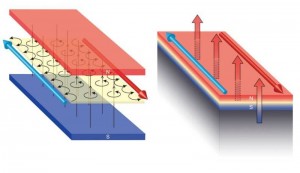A New Material for Dissipationless Electronics Toward Realization of Novel Principle “Quantum Anomalous Hall Effect”


Depiction of quantum Hall effect (left) and quantum anomalous Hall effect (right). © J. G. Checkelsky
When an external magnetic field is applied to a semiconductor, current flows without loss at the material’s edge due to the quantum Hall effect. It has been theoretically predicted that due to the anomalous quantum Hall effect in a special magnetic material, current should flow without energy loss at the material’s edge due to its own magnetic nature.
Researchers at the University of Tokyo and RIKEN have demonstrated a new material that promises to eliminate loss in electrical power transmission. The surprise is that their methodology for solving this classic energy problem is based upon the first realization of a highly exotic type of magnetic semiconductor first theorized less than a decade ago ? a magnetic topological insulator. Professor Yoshihiro Iwasa, Professor Yoshinori Tokura, and Lecturer Jianting Ye (Graduate School of Engineering, Department of Applied Physics) and Yoshinori Onose (Graduate School of Arts and Sciences) worked in collaboration with postdoctoral researcher Joseph Checkelsky at RIKEN. The work by the Todai/RIKEN collaboration is closely related to a landmark discovery from the 1980s, the so-called quantum Hall effect. That effect is known to produce dissipationless electricity channels, but for its operation requires large, cumbersome magnets to produce magnetic fields of 10 Teslas, some 200,000 larger than the earth’s magnetic field. The Todai/RIKEN collaboration circumvented this difficulty by using an exotic type of semiconductor predicted to exhibit a similar effect. In contrast to the quantum Hall effect, this effect, known as the quantum anomalous Hall effect, stems from the semiconductor’s own magnetization rather than from an external one. At the heart of this new phenomenon is the interaction between magnetic ions and the topological insulator’s current-carrying particles (known as Dirac fermions), the latter of which are unique because they behave as if they have zero mass. The devices produced by the Todai/RIKEN team are a robust “proof of principle,” demonstrating that this new type of dissipationless transport can be harnessed in prototype transistors. While currently requiring cryogenic conditions, improvements in materials design promises to improve the stability of the magnets, making it possible to operate them at higher temperatures. By doing away with external stimuli such as magnetic fields and, in the future, cryogenic cooling, these new magnetic topological insulators may represent the most efficient path to modernizing the power grid by eliminating loss in energy transfer.
Press Release (RIKEN)
Paper
J. G. Checkelsky, J. T. Te, Y. Onose, Y. Iwasa, Y. Tokura,
“Dirac-fermion-mediated ferromagnetism in a topological insulator”,
Nature Physics, 2012, doi: 10.1038/nphys2388.
Article link






